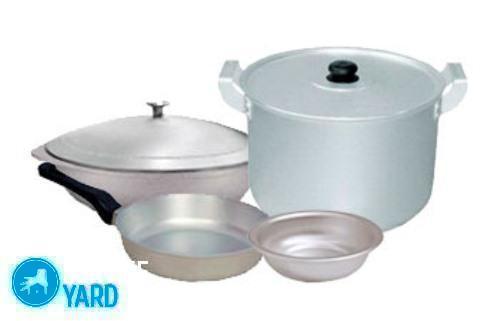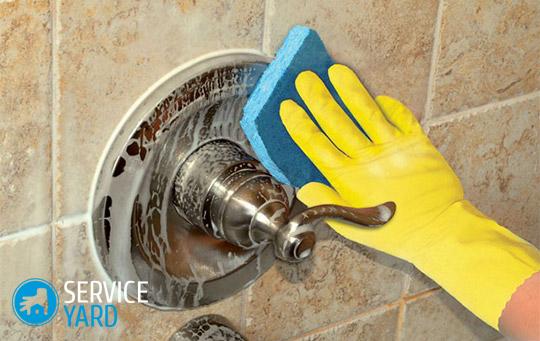How to clean aluminum from oxidation?
In any home, there are products made of lightweight, but strong enough material - aluminum. Such household items include: pots, pans, sinks, window frames and furniture fittings. Like any material, aluminum is covered with dirt and oxide film. To prevent this, you need to know how to clean aluminum from oxidation without damaging the product.
How to remove oxide from aluminum?
Anyone can remove oxides from aluminum at home:
- The easiest way is mechanical, but it can only be used on planes or parts with simple relief.
- To clean metal with a complex-profile relief, it is necessary to use a chemical method - etching.
Let's look at several ways to remove oxide film and other contaminants from household items.
Cleaning kitchen utensils
In order to restore shine to kitchen utensils, you will need the following items and tools:
- Water.
- Soft cloth or dish sponge.
- Vinegar or lemon juice, tartar.
- Dish scraper.
- Mild detergent.
- Salt.
- Towel.
- A bucket or other large container if the dishes need to be cleaned from the outside.
Having prepared everything you need, get to work:
- Wait for the pot or pan to cool down after cooking.
- Remove all grease and dirt from the surface of the cookware. Add dish soap to warm water and rinse off any remaining dirt.
- Use a dish scraper to scrape off any carbon deposits and food debris. If you cannot completely clean the pan with a scraper, then pour some water into the utensil, bring to a boil and scrape the dirt off the metal with a wooden spoon.
- Prepare an acidic solution: 2 tbsp. mix tablespoons of tartar, white vinegar or lemon juice with 1 liter of water.
- Pour the solution into a saucepan.
- Put the utensils on fire and bring the liquid to a boil.
- Boil the solution over low heat for 10-15 minutes.
- As soon as the aluminum brightens, turn off the heat.
- Wait for the saucepan and contents to cool down.
- Pour the solution out of the dish.
- Gently scrub the skillet or pot again with a scraper to remove any remaining dull stains.
- Wipe the dishes with a clean towel.

- Do not use steel wool for cleaning, as it can scratch the surface, and this will lead to dire consequences.
- If you want to clean the dishes not only from the inside, but also from the outside, then place them in a large saucepan or bucket. Pour in an acidic solution, at the rate of: 1 liter of water - 2 tbsp. spoons of weak acid (vinegar, lemon, tartar). Place the container on fire. Boil for 15-20 minutes to remove oxidation from the aluminum.
- If you do not have a large container, you can clean the outside of the pan with cut lemon after dipping it in salt.
- The acidic solution reduces tarnishing of the metal. Therefore, use the juice of sour fruits and vegetables, such as rhubarb or apples, to clean the surface of the dishes. Instead of a solution, you can put the peel of sour apples in the water for boiling - in this simple way you will be able to clean the aluminum from oxidation.
- If you don't want to waste time boiling your utensils, use a mild aluminum cleaner. Use it in the same way as a soft dish brush or soap. Wipe the dishes with a sponge and cleaner, then rinse off with water.
Cleaning aluminum sinks
The aluminum sink must be regularly cleaned of food debris, dirt and oxide film. To make your plumbing shine like new, proceed as follows:
- Scrub the sink gently with a brush, as food particles can interfere with the removal of the oxide layer and make it difficult to clean the surface.
- Clean the plumbing with dish soap.
- Rinse off any remaining detergent thoroughly.
- Cut the lemon in half.
- Dip one citrus half in salt.
- Wipe the surface of the sink with a cooked lemon half.
- Wipe off any salt and lemon residue with a damp cloth.
- Dry the surface of the sink with a dry towel.
Cleaning of products and parts made of aluminum
In our homes, many products are made of light metal, such as aluminum fittings or furniture. Due to surface oxidation, the metal does not rust. However, oxidation itself is considered a form of corrosion. As a result of this process, a thin film is formed on the surface of the metal, which protects it from water. Unfortunately, over time, the oxide film grows and the metal tarnishes. All this negatively affects the appearance of the products. Therefore, it becomes necessary to purify aluminum from oxidation.
To clean aluminum objects in your home and yard, follow these guidelines and tips:
- You can clean the aluminum parts of window frames or doorways with one of the universal detergents, for example, Domestos. Although it is quite corrosive, it will not damage the parts, since such aluminum products are coated with a durable anti-corrosion coating.
- Use the following outdoor cleaning method for aluminum:
- Wash the metal surface with water and a mild detergent such as soap. This is necessary to remove dust, dirt and grease from the coating.
- Use a mild abrasive such as Soft Scrub to remove scratches.
- Rinse off thoroughly with water. A garden hose can be used for this purpose.
- Mix acid and water in a 1: 1 ratio. You can use: vinegar, tartar or lemon juice. If you are processing hardware or aluminum furniture, use a metal polishing paste instead of a mild acid.
- Wipe the metal with a soft dish brush and prepared solution. Try to remove any dark spots caused by oxidation.
- Rinse off the solution with water. Make sure that there are no traces of solution on the surface of the product.
- Wipe the surface thoroughly with a dry cloth.
- Apply a layer of car polish wax to the product. Apply wax with a soft cloth, rubbing in a circular motion.

- Clean metal outdoors in moderate weather, as aluminum does not tolerate too high or too low temperatures.
- When cleaning aluminum surfaces with a steel wool, use the thinnest one. Clean the surface back and forth, but not in a circular motion, to maintain a uniform surface texture.
- Use trisodium phosphate if necessary to clean tough aluminum wall cladding. Mix the preparation with warm water in the proportion: 30-50 grams of the product per 1 liter of water. Apply the resulting solution to the surface, but first protect your eyes and hands with protective equipment.
- To achieve the shine of the metal, you can use the special WD-40 liquid. Handle the product outdoors. Apply the liquid with a cloth or spray. After a couple of minutes, wipe the surface with a hard washcloth or thin twisted steel wire, which is used to remove carbon deposits from the dishes. After processing, wipe the aluminum product clean with a rag.
- Clean the outer aluminum surfaces with ordinary detergent. Dissolve a quarter cup of washing powder without bleach in 8 liters of warm water. Apply the solution with a sponge. After processing, rinse the surface of the product thoroughly with clean cold water.
- Use caustic soda for metal etching. The procedure takes a little time, so it is acceptable at home. You can use the chemical household product "Mole", which is used to remove blockages in the drain. Use the product to cleanse aluminum from oxidation as follows:
- Dissolve 1-2 teaspoons of the product in 0.5 liters of warm water (up to 60 degrees).
- Place the aluminum items in the solution.
- After 1-2 minutes, wash the items with a dish sponge and soap.
- Rinse thoroughly with water.
- Use baking soda to clean metal. Immerse the product in a solution: 2 tbsp. tablespoons of soda per 1 liter of water. Put the container with the contents on fire and boil for 10 minutes. After processing, cool and rinse the item. You can also use a warm solution of caustic soda.
- Remove film of dirty dark color in the following way:
- Dissolve 10 grams of pharmacy borax in a glass of water.
- Add a few drops of ammonia.
- Cover the object with the prepared composition.
- Let the product dry for half an hour.
- Wipe the item with a dry cloth.
Take care of aluminum objects and clean them in time from dirt, food debris, carbon deposits and oxide film. Pay particular attention to objects on the street, as they are most susceptible to oxidation. When working with chemicals, do not forget about protective equipment: glasses, gloves and a respirator.

